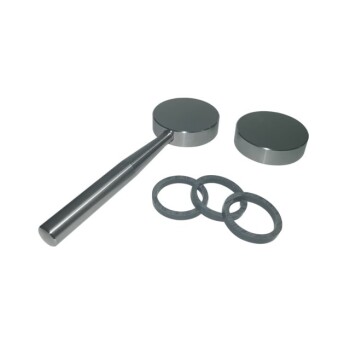An XRF gun, also known as an XRF analyzer or XRF machine, is a sophisticated, non-destructive tool designed for elemental analysis of various materials.
Utilizing energy dispersive X-ray fluorescence (EDXRF) technology, these handheld devices can quickly and accurately determine the elemental composition of a wide range of samples, from metals and minerals to soils and plastics.
Their portability, speed, and ease of use make them invaluable in both field and laboratory settings.
5 Key Points Explained: What Does an XRF Gun Do?

1. Principle of Operation
X-ray Fluorescence (XRF): The core technology behind XRF guns involves firing X-rays at a sample, which causes the sample to emit fluorescent X-rays.
Each element releases a unique 'fluorescent fingerprint' based on its atomic structure.
Detection and Analysis: The emitted fluorescent X-rays are captured by the XRF gun's detector, which then processes these signals to identify the elements present in the sample and their concentrations.
2. Types of XRF Guns
Silicon Drift Detector (SDD): These are newer, more sensitive detectors ideal for measuring light elements and are designed for high count-rate and high sensitivity applications.
They typically provide results in 1-2 seconds.
PIN Detector: Older and less expensive, these detectors are sensitive to heavier elements and may take longer, up to 8-10 seconds, to perform analysis.
3. Applications of XRF Guns
Metallurgy and Alloy Identification: Used in metal scrap sorting, alloy grade identification, and quality control in metal manufacturing.
Environmental Testing: Helps in detecting harmful elements like lead in paints or other contaminants in consumer products.
Geological and Mining Applications: Essential for decision-making in mining operations, including where to focus, when to drill, and sample selection.
Archaeological Research: Provides non-destructive analysis of artifacts, aiding in understanding their composition and age.
Recycling Industry: Crucial for quick and accurate sorting of metals and determining the elemental composition of scrap.
4. Advantages of Portable XRF Guns
Portability: Lightweight and handheld, these devices can be taken directly to the sample, which is particularly useful for large or unwieldy samples that cannot be easily transported to a lab.
Speed and Efficiency: Rapid analysis capabilities allow for real-time decision-making, which is critical in industries like mining and recycling where time is of the essence.
Non-Destructive: Being non-destructive, XRF guns preserve the integrity of the sample, making them ideal for valuable or irreplaceable items like archaeological artifacts.
5. Limitations of XRF Guns
Elemental Sensitivity: XRF guns are less effective with very light elements (below magnesium) and cannot provide information on the chemical structure of compounds.
Radiation Concerns: While generally safe, there are inherent radiation risks associated with the use of X-ray technology, necessitating careful handling and adherence to safety protocols.
In summary, an XRF gun is a versatile and powerful tool for elemental analysis, offering rapid, non-destructive testing across a broad spectrum of applications.
Its ability to provide detailed elemental composition data in real-time makes it an indispensable asset in numerous industries, from mining and metallurgy to environmental science and archaeology.
Continue Exploring, Consult Our Experts
Discover how an XRF gun revolutionizes elemental analysis! With KINTEK SOLUTION's cutting-edge devices, you can achieve rapid, non-destructive testing in minutes.
From metallurgy to environmental testing, our advanced XRF technology is the key to unlocking detailed composition insights.
Don't miss out on the efficiency and accuracy that KINTEK SOLUTION brings to your lab.
Get in touch with our experts today to explore how our XRF guns can elevate your analytical capabilities!











